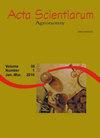Proteome in regrowth cycles of sugarcane: Absence of proteins to tolerate adverse growth conditions may be related to reduced agricultural productivity
IF 1.2
4区 农林科学
Q3 AGRONOMY
引用次数: 0
Abstract
One of the main objectives of sugarcane plantations is to increase their longevity without decreasing agricultural productivity. In the present study, we analyzed the proteome of the axillary buds of ‘RB966928’ to investigate possible changes in the number of proteins at different cutting stages. Using tryptic digestion followed by ultra-performance liquid chromatography coupled with high-resolution time-of-flight mass spectrometry, 122 proteins were identified from the proteome of the axillary buds of ‘RB966928’. Of the 122, respectively 97 and 95 proteins were detected at the first and fifth cutting stages, of which 27 and 25 proteins were unique to the respective stage. Proteins that prevent the misfolding of polypeptides generated under stress were exclusively detected at the first cutting stage. Meanwhile, proteins associated with stress responses and disease resistance were exclusively detected at the fifth cutting stage. The present proteomic analysis in the regrowth cycles and axillary bud development of ‘RB966928’ significantly advanced our understanding of the biological processes linked to the reduction of agricultural productivity of sugarcane with the advancement of cutting age. Absence of proteins to tolerate adverse growth conditions at the fifth cutting stage may be related to reduced agricultural productivity, in addition to environmental stress, soil compaction, nutrient availability, cultural practices, and pests or pathogen attacks at different phenological stages of crops.甘蔗再生周期中的蛋白质组:缺乏耐受不利生长条件的蛋白质可能与农业生产力下降有关
甘蔗种植园的主要目标之一是在不降低农业生产力的情况下延长其寿命。在本研究中,我们分析了RB966928 '腋芽的蛋白质组,以探讨不同切割阶段蛋白质数量的可能变化。采用胰蛋白酶消化-超高效液相色谱-高分辨率飞行时间质谱联用技术,从RB966928的腋芽蛋白质组中鉴定出122个蛋白。在122个蛋白中,在第1和第5切割阶段分别检测到97和95个蛋白,其中27和25个蛋白是各自阶段特有的。防止在胁迫下产生的多肽错误折叠的蛋白质仅在第一次切割阶段被检测到。与此同时,与胁迫反应和抗病相关的蛋白只在第5个扦插期被检测到。通过对RB966928再生周期和腋芽发育的蛋白质组学分析,我们进一步了解了随着采伐年龄的增加,甘蔗农业生产力下降的生物学过程。除了环境胁迫、土壤压实、养分有效性、栽培方法以及作物不同物候阶段的害虫或病原体攻击外,在第5个刈割阶段缺乏耐受不利生长条件的蛋白质可能与农业生产力下降有关。
本文章由计算机程序翻译,如有差异,请以英文原文为准。
求助全文
约1分钟内获得全文
求助全文
来源期刊

Acta Scientiarum. Agronomy.
Agricultural and Biological Sciences-Agronomy and Crop Science
CiteScore
2.40
自引率
0.00%
发文量
45
审稿时长
>12 weeks
期刊介绍:
The journal publishes original articles in all areas of Agronomy, including soil sciences, agricultural entomology, soil fertility and manuring, soil physics, physiology of cultivated plants, phytopathology, phyto-health, phytotechny, genesis, morphology and soil classification, management and conservation of soil, integrated management of plant pests, vegetal improvement, agricultural microbiology, agricultural parasitology, production and processing of seeds.
 求助内容:
求助内容: 应助结果提醒方式:
应助结果提醒方式:


